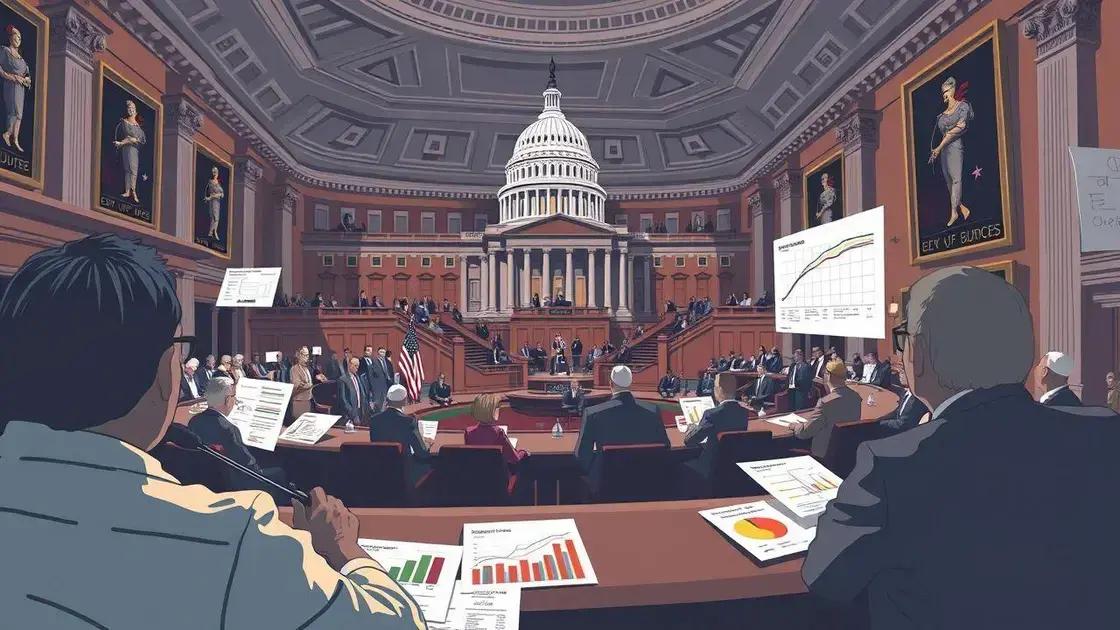Understanding the U.S. federal budget process and its impact

Understanding the U.S. federal budget process reveals how government funding decisions impact essential services, citizen engagement, and financial transparency in managing public resources.
Understanding the U.S. federal budget process is crucial for anyone interested in how government spending impacts our lives. Have you ever wondered where tax dollars go? Let’s dive in and explore.
What is the federal budget process?
The federal budget process is a vital part of how the U.S. government operates. It involves planning and approval of spending by various government agencies. Understanding this process helps citizens see how public funds are allocated and spent.
Stages of the Budget Process
Each year, the federal budget goes through a series of stages. This ensures that funds are used wisely and align with national priorities. These stages include:
- Preparation: Agencies submit requests based on their needs and goals.
- Submission: The President presents a budget proposal to Congress.
- Review: Congress reviews, amends, and approves the budget.
- Implementation: Funds are allocated, and agencies can start spending.
The budget process also involves various stakeholders, from the President to members of Congress and the public. Each group plays a role in shaping the budget, influencing how money is spent on programs and services.
The Role of Congress
Congress has a special responsibility in the budget process. Its duties include not just approval but also oversight. Members of Congress debate proposed budgets and can suggest changes that reflect their constituents’ needs. This oversight helps maintain a checks and balances system where spending is monitored and controlled.
Also, public involvement is crucial. Citizens can express their opinions during the budget formulation process. This feedback can impact the final decisions made by Congress. Overall, the budget process reflects the government’s priorities and directly affects daily life.
Key players in the budget process
In the federal budget process, various key players contribute to shaping how funds are allocated and managed. Understanding these players helps clarify how decisions are made.
The President
The President plays a crucial role in the budget process. They prepare and submit the initial budget proposal to Congress. This proposal outlines the government’s spending priorities and reflects the administration’s goals. The President’s influence is significant as they can push for specific funding or cuts in various programs.
Congressional Committees
Congress holds a significant check on the budget process. Various committees, like the House and Senate Appropriations Committees, analyze the President’s proposal. They hold hearings to question department heads and gather information. Through these hearings, they seek to ensure that funds are spent effectively.
- House Appropriations Committee: Focuses on appropriating funds for government agencies.
- Senate Appropriations Committee: Works on reviewing and approving spending bills.
- Budget Committees: Draft the budget resolution that sets overall spending limits.
These committees play an essential role in reviewing, modifying, and approving the budget, ensuring that it aligns with national interests.
Government Agencies
Government agencies also have a voice in the budget process. Each agency submits funding requests based on its needs. They justify these requests by outlining how the funds will carry out programs and services. This interaction with Congress is vital for securing the necessary resources.
Additionally, the public can engage by contacting their representatives to share their priorities. This feedback can influence budgetary decisions, making public input an important aspect of the budget process.
The stages of budget formulation

The stages of budget formulation are critical to ensuring that the federal budget is planned correctly. Each stage plays a unique role in how funds are allocated and spent.
1. Preparation of Budget Requests
During this stage, federal agencies prepare their budget requests. They assess their needs based on previous spending and future goals. This involves thorough planning, where each agency justifies how much funding they require and for what purposes. A well-prepared request is essential for securing the necessary resources.
2. Presidential Budget Proposal
After agencies submit their requests, the next stage is the President’s proposal. The President and their budget team review all the requests and prioritize spending. They draft a proposal that outlines the administration’s vision for federal spending. This proposal is critical as it reflects the government’s priorities and is submitted to Congress each February.
3. Congressional Review
Once Congress receives the President’s budget proposal, the review process begins. Congressional committees analyze the proposal in detail. They hold hearings where they question agency leaders about their requests. This is a crucial step to ensure that funds are allocated effectively and align with national interests.
- Debate and Amendments: Members of Congress can propose changes and adjustments.
- Budget Resolutions: Congress must pass a budget resolution to set spending limits.
- Appropriations Bills: These bills provide specific funding to various agencies.
Throughout this review, public input may influence congressional decisions. Citizens can voice their opinions to their representatives, shaping the final budget.
4. Finalization and Implementation
After thorough discussion, Congress votes on the budget. Once approved, the budget is signed into law by the President. This final stage allows federal agencies to implement their plans and spend the allocated funds. The budget serves as a blueprint for government spending for the upcoming fiscal year.
How budget decisions affect citizens
Understanding how budget decisions affect citizens is crucial for grasping the impact of government spending. These decisions shape every aspect of public life, from education to healthcare.
Direct Impact on Services
Budget decisions determine the funding available for essential services. For instance, schools rely on federal and state budget allocations for teachers, materials, and programs. When budgets are tight, schools may cut staff or resources, affecting students directly. Similarly, healthcare programs like Medicare and Medicaid rely heavily on budget decisions that impact coverage and care quality.
Economic Implications
The federal budget also affects the economy at large. Budget decisions influence tax policies, which can lead to changes in disposable income for families. When taxes increase to cover government spending, citizens may have less money to spend on essentials. Alternatively, if the budget supports tax cuts, families may have more disposable income, boosting local economies.
- Job Creation: Budget allocations for infrastructure can create jobs.
- Public Welfare: Funding for social programs can reduce poverty levels.
- National Security: Military budgets influence safety and defense spending that protects citizens.
Thus, budget choices extend beyond mere numbers. They create ripples through society, impacting jobs, public services, and economic growth.
Civic Engagement
Citizens have a voice in how budget decisions are made. Public hearings and community meetings allow people to express their opinions on budget priorities. When citizens engage with their representatives, they can influence decisions that affect their communities. Knowing how budget outcomes impact daily life encourages civic participation, fostering a more engaged and informed citizenry.
Understanding budget transparency and accountability
Understanding budget transparency and accountability is crucial for citizens to see how their tax dollars are used. Transparency means that budget documents are open and accessible to the public, allowing citizens to review where money is going. This access helps promote trust in government.
The Importance of Transparency
Transparency in the budget process allows citizens to understand government spending. It encourages responsible financial management and reduces the risk of corruption. When the public can see budget reports, they are better informed about government priorities and how decisions are made.
Tools for Accountability
To ensure accountability, various tools are used. Government agencies publish budget summaries, spending data, and performance evaluations. These reports should be easy to read and available online. When agencies explain how funds are used, citizens can hold them accountable for their actions.
- Open Budget Data: This allows the public to access detailed information about budget allocations.
- Public Hearings: Citizens can voice their opinions on budget proposals during community meetings.
- Performance Audits: These analysis reports ensure funds are spent effectively and efficiently.
Through these methods, citizens can track how well the government uses taxpayer money. When they notice discrepancies or poor performance, they have the means to advocate for change.
The Role of Civic Engagement
Civic engagement is essential for maintaining budget transparency and accountability. When citizens actively participate in local government, they create a culture of openness. Engaged citizens can attend budget meetings, ask questions, and provide feedback. Their involvement sends a message that accountability matters.
By understanding budget transparency and accountability, citizens become empowered. They can demand better governance and ensure that public funds serve the community’s best interests.
FAQ – Frequently Asked Questions about the U.S. Federal Budget Process
What is the federal budget process?
The federal budget process involves planning, drafting, and approving the budget required to fund government programs and services for the fiscal year.
How does the budget affect citizens?
The budget impacts key services that citizens rely on, such as education, healthcare, and infrastructure, influencing quality and availability.
What role does transparency play in budgeting?
Transparency allows citizens to see how tax dollars are spent, promoting trust and accountability in government spending.
Can citizens influence budget decisions?
Yes, citizens can participate in the budgeting process by attending meetings, giving feedback, and communicating with their representatives.





